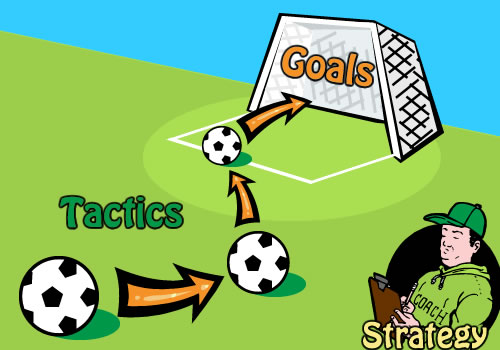Effective strategies balance organizations’ capabilities (strengths) and vulnerabilities (weaknesses) against the opportunities, risks, and barriers associated with goals. Many of these opportunities, risks and barriers can be characterized as non-market issues. Consequently, comprehensive strategies can include several important non-market dimensions.
What is strategy?

Just threw this together using some artwork. If it doesn't work/capture what you need, just let me know.
The term "strategy" can best be understood in the context of "goals" and "tactics." Goals (and/or objectives) are the measurable outcomes that serve a purpose (or mission), for an organization or an individual. Tactics are the specific actions executed to achieve goals. And strategies make sure that tactics serve goals–strategies are the plans used to identify, organize, and focus tactics to achieve goals (thereby serving a purpose.)
Consider our example from the previous lesson [check to see that this example still is in the previous lesson], wherein you are trying to site a transmission line for your planned solar array project in the desert. Your mission may be to establish a profitable renewable energy organization utilizing solar-electric technology. In order to serve your mission, one of your goals is to install a reliable solar array at relatively low cost. In order to balance several elements of that goal (i.e., reliable and low-cost), your strategy is to purchase solar panels that are one generation older than the state of the art (for cost savings and reliability.) And you’ve also decided to employ a construction firm experienced in solar array installations utilizing an incentive-based contract (again, to balance reliability with cost savings.) This strategy helps to identify the tactics to achieve your objective.
One of your tactics could be to hire a solar technology consultant to prepare a report summarizing the age, price, and reliability of solar technologies currently available in the marketplace. Another tactic could be to hire a law firm experienced in negotiating incentive-based contracts. And yet another could be to require that all bids for the installation contract include a list of previous solar installations, so that you can judge prospective contractors’ levels of experience. Your market-based strategy is implemented through these market-based tactics in order to achieve your goal to install a reliable solar array at relatively low cost.
Non-Market Strategy
An alternative strategy may necessitate non-market tactics. For example, your goal could also be pursued through a strategy to attract government subsidies, grants, or loans. Indeed, your strategy could be to organize as a not-for-profit corporation. These strategies can be implemented through a variety of non-market tactics, such as applying for specific grants and building relationships with granting and regulatory authorities. These are referred to as non-market strategies because they are intended to achieve resource allocations (i.e., in this case, allocation of grants and permits) through social and political processes that differ from market-mediated economic decision making.
As discussed in the previous lesson, another goal necessary to achieving your mission is to site and install a relatively direct and cost-effective transmission line connecting your solar array to the grid. Can you think of alternative strategies for achieving this goal? Can you distinguish between market and non-market tactics that may be employed to implement those strategies?
[note: TWO QUESTIONS ABOVE COULD BE USED AS IN-LECTURE EXERCISE. I COULD DRAFT A FEW BULLETS SUGGESTING ONE SOLUTION TO THOSE QUESTIONS. E.G. “Purchase privately-owned parcels of land to construct transmission corridor from solar array to grid. This would be a relatively market-based strategy that could be implemented through discreet land purchases. Alternatively, you could purchase only enough land to provide a right-of-way to the nature preserve boundary (i.e. the nature preserve that we imagined was a shortcut to the nearest opportunity to connect to the grid.) Since this would require regulatory approval, and NGO’s would have more standing to protest, this strategy would be considered a relatively non-market alternative. This strategy would necessitate tactics such as lobbying congressmen, employing technical experts in order to increase informal authority in the discussion about whether you would damage the preserve, etc.]
